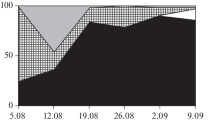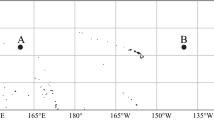Abstract
Dissolved microcystins (MCs) are regularly present in water dominated by microcystin-producing, bloom-forming cyanobacteria. In vitro experiments with environmentally feasible concentrations (5 × 10−7 M) of the three most common microcystins, MC-LR, MC-RR, and MC-YR, revealed that they influence the metabolism of different representative phytoplanktons. At light intensities that are close to the cyanobacterial bloom environment (50 μmol m−2 s−1), they produce morphological and physiological changes in both microcystin-producing and -nonproducing Microcystis aeruginosa strains and also have similar effects on the green alga Scenedesmus quadricauda that is frequently present in cyanobacterial blooms. All three microcystin variants tested induce cell aggregation, increase in cell volume, and overproduction of photosynthetic pigments. All three effects appear to be related to each other but are not necessarily caused by the same mechanism. The biological activity of microcystins toward the light-harvesting complex of photobionts can be interpreted as a signal announcing the worsening of light conditions due to the massive proliferation of cyanobacteria. Although the function of microcystins is still unknown, it is evident that they have numerous effects on phytoplankton in nature. These effects depend on the individual organism as well as on the various intracellular and extracellular signaling pathways. The fact that dissolved microcystins also influence the physiology of microcystin-producing cyanobacteria leads us to the conclusion that the role of microcystins in the producing cells differs from the role in the water environment.








Similar content being viewed by others

References
Abe, T, Lawson, T, Weyers, JDB, Codd, GA (1996) Microcystin-LR inhibits photosynthesis of Phaseolus vulgaris primary leaves: implications for current spray irrigation practice. New Phytol 133: 651–658
Allen, JF (1992) Protein phosphorylation in the regulation of photosynthesis. Biochim Biophys Acta 1098: 275–335
Campbell, D, Hurry, V, Clarke, AK, Gustafsson, P, Öquist, G (1998) Chlorophyll fluorescence analysis of cyanobacterial photosynthesis and acclimation. Microbiol Mol Biol Rev 62: 667–683
Dittmann, E, Neilan, BA, Erhard, M, von Döhren, H, Börner, T (1997) Insertional mutagenesis of a peptide synthetase gene that is responsible for hepatotoxin production in the cyanobacterium Microcystis aeruginosa PCC 7806. Mol Microbiol 26: 779–787
Giardi, MT, Cona, A, Geiken, B (1995) Photosystem II core phosphorylation heterogeneity and the regulation of electron transfer in higher plants: a review. Bioelectrochem Bioenerg 38: 67–75
Gliwicz, ZM (1990) Why do cladocerans fail to control algal blooms? Hydrobiol 200/201: 83–97
Grach-Pogrebinsky, O, Sedmak, B, Carmeli, S (2003) Protease inhibitors from a Slovenian Lake Bled toxic waterbloom of the cyanobacterium Planktothrix rubescens. Tetrahedron 59: 8329–8336
Hagmann, L, Jüttner, F (1996) Fischerellin A, a novel photosystem-II-inhibiting allelochemical of the cyanobacterium Fischerella muscicola with antifungal and herbicidal activity. Tetrahedron Lett 37: 6539–6542
Haney, JF (1987) Field studies on zooplankton–cyanobacteria interactions. N Z J Marine Freshwater Res 21: 467–475
Hesse, K, Dittmann, E, Börner, T (2001) Consequences of impaired microcystin production for light-dependent growth and pigmentation of Microcystis aeruginosa PCC 7806. FEMS Microbiol Ecol 39–43
Hughes, EO, Gorham, PR, Zehnder, A (1958) Toxicity of an unialgal culture of Microcystis aeruginosa. Can J Microbiol 4: 225–236
Jungmann, D, Ludwichowski, KU, Faltin, V, Benndorf, J (1996) A field study to investigate environmental factors that could effect microcystin synthesis of a Microcystis population in the Bautzen reservoir. Int Rev Gesamten Hydrobiol 81: 493–501
Kato, T, Watanabe, MF, Watanabe, M (1991) Alloenzyme divergence in Microcystis (Cyanophyceaea) and its taxonomic and phylogenetic inference. In: Hickel, B, Anagnostidis, K, Komarek, J (Eds.) Cyanophyta/Cyanobacteria—Morphology, Taxonomy, Ecology. Proceedings of the 11th Symposium of the IACR, Plon, Germany, 1989 (Arch Hydrobiol Suppl 92, Algological Studies 64: 129–140)
Kolber, Z, Wyman, KD, Falkowski, PG (1990) Natural variability in photosynthetic energy conversion efficiency: a field study in the Gulf of Maine. Limnol Oceanogr 35: 72–79
Kromkamp, JC, Walsby, AE (1990) A computer model of buoyancy and vertical distributions in populations of Microcystis in two shallow lakes. J Plankton Res 13: 419–436
Kurmayer, R, Christiansen, G, Chorus, I (2003) The abundance of microcystin-producing genotypes correlates positively with colony size in Microcystis sp. and determines its microcystin net production in lake Wannsee. Appl Environ Microbiol 69(2): 787–795
Lazar, D (1999) Review—chlorophyll a fluorescence induction. Biochim Biophys Acta 1421: 1–28
Lee, T, Tsuzuki, M, Takeuchi, T, Yokoyama, K, Karube, I (1994) In vivo fluorimetric method for early detection of cyanobacterial waterblooms. J Appl Phycol 6: 489–495
Lin, CG (1972) Phytoplankton succession in Lake Valencia, Venezuela. Hydrobiologia 138: 189–203
MacKintosh, C, Beattie, KA, Klumpp, S, Cohen, P, Codd, GA (1990) Cyanobacterial microcystin-LR is a potent and specific inhibitor of protein phosphatases 1 and 2A from both mammalian and higher plants. FEBS 264: 187–192
Papageorgiou, GC (1996) The photosynthesis of cyanobacteria (blue bacteria) from the perspective of signal analysis of chlorophyll a fluorescence. J Sci Ind Res 55: 596–617
Park, HD, Iwami, C, Watanabe, MF, Harada, KI, Okino, T, Hayashi, H (1998) Temporal variabilities of the concentrations of intra- and extracellular microcystin and toxic Microcystis species in a hypertrophic lake, Lake Suwa, Japan (1991–1994). Environ Toxicol Water Qual 13: 61–72
Reynolds, CS (1975) Interrelations of photosynthetic behaviour and buoyancy regulation in a natural population of a blue-green alga. Freshwater Biol 5: 323–338
Reynolds, CS (1984) The Ecology of Freshwater Phytoplankton. Cambridge University Press, Cambridge, p 384
Reynolds, CS, Thompson, JM, Ferguson, AJD, Wiseman, SW (1982) Loss processes in the population dynamics of phytoplankton maintained in closed systems. J Plankton Res 4: 561–600
Sedmak, B, Kosi, G (1997) Microcystins in Slovene freshwaters (central Europe)—first report. Nat Toxins 5: 64–73
Sedmak, B, Kosi, G (1998) The role of microcystins in heavy cyanobacterial bloom formation. J Plankton Res 20: 691–708
Sedmak, B, Kosi, G (1998) Erratum. The role of microcystins in heavy cyanobacterial bloom formation. J Plankton Res 20: 1421
Sedmak, B, Kosi, G (2002) Harmful cyanobacterial blooms in Slovenia-bloom types and microcystin producers. Acta Biol Slov 45: 17–30
Singh, DP, Tyagi, MB, Kumar, A, Thakur, JK, Kumar, A (2001) Antialgal activity of a hepatotoxin-producing cyanobacterium Microcystis aeruginosa. World J Microbiol Biotechnol 17: 15–22
Sivonen, K (1990) Effects of light, temperature, nitrate, orthophosphate, and bacteria on growth of and hepatotoxin production by Oscillatoria agardhii strains. Appl Environ Microbiol 56: 2658–2666
Smayda, TJ, Boleyn, BJ (1965) Experimental observations on the flotation of marine diatoms. I. Thalasiosira cf. nana, Thalassiosira rotula and Nitzschia seriata. Limnol Oceanogr 10: 499–509
Sukenik, A, Eshkol, R, Livne, A, Hadas, O, Kaplan, A, Tcernov, D, Vardi, A, Rom, M (2002) Inhibition of growth and photosynthesis of the dinoflagellate Peridinium gatunense by Microcystis sp. (cyanobacteria): a novel allelopathic mechanism. Limnol Oceanogr 47: 1656–1663
Thompson, AS, Rhodes, JC, Pettman, I (1988) Culture Collection of Algae and Protozoa—Catalogue of Strains, 5th Ed. Natural Environment Research Council, Titus Wilson and Son Ltd., Kendal, Ambleside, UK, p 22
Tsuchiya, Y, Watanabe, M (1997) Disk type solid-phase extraction of microcystin in environmental water. Jpn J Toxicol Environ Health 43: 190–196
Vardi, A, Schatz, D, Beeri, K, Motro, U, Sukenik, A, Levine, A, Kaplan, A (2002) Dinoflagellate–cyanobacterium communication may determine the composition of phytoplankton assemblage in a mesotrophic lake. Curr Biol 12: 1767–1772
Vollenweider, RA (1969) Primary Production in Aquatic Environments. Internal Biology Program Handbook 12. Blackwell Scientific Publications, Oxford, p 213
Walsby, AE (1994) Gas vesicles. Microbiol Rev 58: 94–144
Watanabe, MF, Watanabe, M, Kato, T, Harada, KI, Suzuki, M (1991) Composition of cyclic peptide toxins among strains of Microcystis aeruginosa (blue-green algae, cyanobacteria). Bot Mag Tokyo 104: 49–57
Wetzel, RG, Likens, GE (1995) Composition and biomass of phytoplankton. In: Limnological Analyses, 2nd edn. Springer-Verlag, New York, pp 139–165
Acknowledgment
The authors are thankful to Professor Roger Pain for reading the revised manuscript, to Dr. Andrej Blejec for helping us with statistical analyses, and to Karmen Staniè for technical support. The work was supported by grant P-508 (“Ecotoxinology and Ecotoxicology”) from the Ministry of Education, Science and Sport of Slovenia.
Author information
Authors and Affiliations
Corresponding author
Rights and permissions
About this article
Cite this article
Sedmak, B., Eleršek, T. Microcystins Induce Morphological and Physiological Changes in Selected Representative Phytoplanktons. Microb Ecol 51, 508–515 (2006). https://doi.org/10.1007/s00248-006-9045-9
Received:
Accepted:
Published:
Issue Date:
DOI: https://doi.org/10.1007/s00248-006-9045-9



